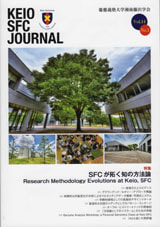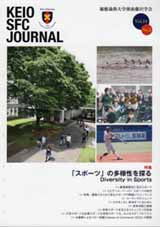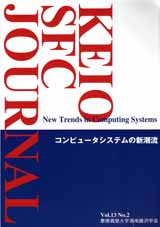- HOME
- KEIO SFC JOURNAL
- Vol.14 No.1

KEIO SFC JOURNAL Vol.14 No.1 Research Methodology Evolutions at Keio, SFC
published on 2014.09
-
Evidence Based Practice and Evaluation of Community Intervention - Complex Intervention and Mixed Methods
Miki Akiyama Associate Professor, Faculty of Environment and Information Studies, Keio University This article discusses methodology for evidence-based community intervention practices, which involves a number of interacting variables and components. After introducing "complex interventions" and "mixed methods", which are increasingly well known and used in the health service and public health practice, this article examines a case of large-scale community intervention studies which had taken place in an area of palliative care in Japan. Elements of each development and evaluation process are practical and widely applicable to other areas of social policy such as education and community development.
Download this article (PDF): SFCJ14-1-01.pdf -
Overview of Grounded Theory Approach
Shigeko Saiki-Craighill Professor, Faculty of Nursing and Medical Care, Graduate School of Health Management, Keio University This article, after describing the current state of qualitative research in Japan, conducts an overview of the Grounded Theory Approach (hereinafter referred to as GTA), focusing on its unique characteristics and the steps involved in using GTA. In qualitative research, researchers themselves become tools for collecting and analyzing data. The strength of GTA is that during both data collection and data analysis, it minimizes the researcher's bias, and that during data analysis, GTA makes it possible for researchers to share their interpretations and facilitates their ability to generate new ideas.
Download this article (PDF): SFCJ14-1-02.pdf -
Impression-Based Multimedia Retrieval & Visualization System with Temporal Aesthetic Features Analysis on Media Streams
Shuichi Kurabayashi Assistant Professor, Faculty of Environment and Information Studies, Keio University This paper shows an impression-based video and music search and visualization system that realizes emotional semantic video retrieval by analyzing aesthetic features of a whole media stream. This system is effective to retrieve videos which are unfamiliar to users because users do not have to know detailed information. This system models multimedia data as time-series media data having various contexts, such as video and audio data distributed on the Web and live images acquired from a Web camera. This system finds media data from the viewpoint of impression concerning aesthetic presentation of a whole video stream, which conventional video and audio retrieval approaches have not support well because many of those approaches focus on fragments of media data.
Download this article (PDF): SFCJ14-1-03.pdf -
Design Research Through Practice as an Interdisciplinary Field of Enquiry -Research into, for, through Design
Daijiro Mizuno Assistant Professor, Faculty of Environment and Information Studies, Keio University Recent developments in design research through practice have proven to be "academically valid" among the design research community. Whilst the embodiment of design knowledge contributes to trigger dialogue between multiple stakeholders, its historiography has not been fully understood in Japan. This paper examines the historical context in which the design research situates in an attempt to contextualise meta design in the context of constructive design research.
Download this article (PDF): SFCJ14-1-04.pdf -
Pattern Languages as Media for Creative Dialogues -A Case Study on the Learning Patterns
Takashi Iba Associate Professor, Faculty of Policy Management, Keio University This paper puts light on Pattern Languages as media for recognition, thinking, and communication in the dynamic and complex world. Pattern Language is a methodology for extracting and utilizing common patterns among experiences and cases from the past. Originally invented for architectural design, the method became widely used for software design, and now is becoming applied to new areas of "design" in the broad sense. This paper introduces the case of the Learning Patterns, a pattern language for active and creative learning, and demonstrates that a pattern language functions as media for creative dialogue. In addition, the creation process of pattern languages is also shown.
Download this article (PDF): SFCJ14-1-05.pdf -
Re-examining Oral History Method - Dialogue Analysis of Utterance Sequences
Yuichiro Shimizu Associate Professor, Faculty of Policy Management, Keio University Masaki Suwa Professor, Faculty of Environment and Information Studies, Keio University Interviewing is used widely in qualitative study, but its traditional method has relied on experiential knowledge or anecdotal techniques too much. Whether or not those techniques are effective has been rarely validated. The present paper is a challenge to demystify what really constitutes experiential knowledge on interviewing or examine the effectiveness of the anecdotal techniques. For this purpose, we have analyzed the relationship between questions by interviewers and answers by an interviewee, seeing interviewing as a communication between an interviewer and an interviewee or a collaborative work by both. This is a case study in which the interviewee is a restaurant owner in a town near our university. From intensive interviews (3 times and 2 hours per one time), we have found out interesting evidence suggesting that part of experiential knowledge or anecdotal techniques is not necessarily sound. First, the traditional method was based on a belief that subjective opinions of an interviewer affect the interviewee too much, and therefore should be inhibited. Our evidence, however, shows that subjective opinions of interviewers encouraged the interviewee to open his mind and talk about his thoughts from the bottom of his heart. Secondly, related to the first evidence, interviewers should be cautious to show their hypotheses to the interviewee. Presenting hypotheses sometimes stirs up a feeling of discomfort to the interviewee or sometimes leads to a fruitful response by the interviewee. The latter were cases in which the presented hypotheses were good matches to the interviewee's thoughts or life philosophy.
Download this article (PDF): SFCJ14-1-06.pdf -
An Introduction to Islam as a Methodology
Atsushi Okuda Professor, Faculty of Policy Management, Keio University Director, Laboratory of Islamic Studies, Keio Research Institute at SFC What is the meaning of "Islam as a methodology" for studies on humans and their societies? Firstly, I deal with Descartes' "Discourse on Method" in order to clarify the existence of the God as" a complete one" on the assumption of the way of rational thinking. Then, I show that the teachings of the God are essential for rational thought from a comparison of representative works of Max Weber, Durkheim and Ibn Khaldun. In addition, I will consider it along with some knowledge of Islamic theology how this methodology being based on the faith of Islam, can be "a real mirror", when seeking the truth of humans and their societies.
Download this article (PDF): SFCJ14-1-07.pdf
-
Genome Analysis Workshop: a Personal Genomics Class at Keio SFC
Kazuharu Arakawa Project Associate Professor, Graduate School of Media and Governance, Keio University Masaru Tomita Director, Institute for Advanced Biosciences, Keio University / Professor, Graduate School of Media and Governance, Keio University / Professor, Faculty of Environment and Information Studies, Keio University Because of the development of sequencing technologies, the era of personal genomics is rapidly approaching, and several Direct-to-Consumer genetic testing services are already available. However, sociopolitical guidelines for personal genomics have lagged behind technological advances. Here, we report our innovative literacy education class on personal genomics in Keio University Shonan Fujisawa Campus, using an actual personal genome as the course material.
Download this article (PDF): SFCJ14-1-08.pdf -
The Roles and Prospects of Self-Recommended Admission -Evidence from Keio University, Shonan Fujisawa Campus
Makiko Nakamuro Associate Professor, Faculty of Policy Management, Keio University Natsuki Fujiwara Fourth year, Faculty of Policy Management, Keio University Shuntaro Iguchi Fourth year, Faculty of Policy Management, Keio University The purpose of this research is to examine how students who passed the self-recommended admissions performed after their enrollments. The data was collected from students who have attended Keio University, Shonan Fujisawa Campus, which first started the self-recommended admissions in Japan. The empirical analyses by using a wide variety of statistical methods to control for selection bias showed that students who passed the self-recommended admission is outperformed over their counterparts who passed general entrance examinations in terms of leadership, a sense of purpose, a sense of identification, and mental health.
Download this article (PDF): SFCJ14-1-09.pdf
-
Design of a Tool to Support Learning in the Field of International Development
Yosuke Tsuchiya Assistant, Faculty of Global Media Studies, Komazawa University This paper presents information on features and performances of a tool that the author has designed to support learning in the field of International Development. The proposed tool in this time is the application working on the laptops, and it includes the following two functions: One is to classify and visualize various types of records in the field (like photos, video and etc.) with using temporal and spatial metadata. Another is to share those records via the Cloud System. After the verification, it was confirmed that there were some positive effects of the tool on user's behaviors or performances for learning in the field.
Download this article (PDF): SFCJ14-1-10.pdf -
Cognition about China of the Japan General-Interest Magazines in the 1980s -Focusing on China-related Articles of "Sekai","Chūōkōron" and "Bungeishunjū" Magazines
Zheng Lin Doctoral Program, Graduate School of Japanese Department, Beijing Foreign Studies University The purpose of this article is to make clear the characteristics of China's perception by Japanese society in the 1980s, by looking at the China-related articles of general interest magazines that had an influence on Japanese society, to examine what kind of China-related issues were discussed in Japanese society and what kind of people were the leaders of the discourse on China in this period. The results of the investigation are that according to the differences in the stances of these magazines, clear differences exists between them with regard to various aspects like the level of interest toward China, the reporting tendency of the articles, or the drift of the arguments, and that if we classify these magazines into the categories of left-wing, centrist and right-wing in this order, their order generally speaking becomes: "Sekai", "Chūōkōron", "Bungeishunjū".
Download this article (PDF): SFCJ14-1-11.pdf -
Recent Developments in Economics: Characteristics, Problems, and Remedies
Mitsuaki Okabe Professor Emeritus, Keio University Economics has recently been expanding in its scope and methodology. In this note, we take up and review the themes of research topic that have been presented at recent meetings of the American Economic Association and the Japanese Economic Association, and point out recent trends, some problems, and possible remedies.
Download this article (PDF): SFCJ14-1-12.pdf -
Download this article (PDF): SFCJ14-1-13.pdf
Toward a Society Keeping Community Health: Circles of "Life" Generated by "Connectivity" Authored by Miki Akiyama, Iwanami Shoten, August 2013, 232 pages
Reviewed by Mitsuaki Okabe Professor Emeritus, Keio University

